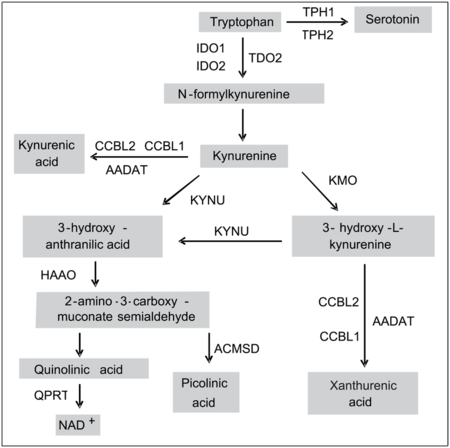Kynurenine pathway
This article is a stub. |
The kynurenine pathway or tryptophan kynurenine pathway is the primary route for metabolizing the essential amino acid tryptophan in humans and other mammals[1] in order to generate cellular energy in the form of nicotinamide adenine dinucleotide (NAD+).[2][3]
If the kynurenine pathway becomes dysregulated or overactive, it can activate the immune system and result in a build-up of potentially neurotoxic compounds in the body.[3]
Function[edit | edit source]

Key: IDO1: indoleamine 2,3-dioxygenase 1; IDO2: indoleamine 2,3-dioxygenase 2; TDO2: tryptophan 2,3-dioxygenase; TPH1: Tryptophan hydroxylase 1; TPH2: Tryptophan hydroxylase 2; AFMID: arylformamidase; KMO: kynurenine 3-monooxygenase; CCBL1: kynurenine aminotransferase I; AADAT: kynurenine aminotransferase II; CCBL2: kynurenine aminotransferase III; KYNU: kynureninase; HAAO: 3-hydroxyanthranilate 3,4-dioxygenase; QPRT, quinolinate phosphoribosyl transferase; ACMSD: aminocarboxymuconate semialdehyde decarboxylase. Source: Favennec et al. (2016). PLoS ONE 11(6): e0158051
ME/CFS[edit | edit source]
The metabolic trap hypothesis suggests that a metabolic problem exists in one or more areas of a person with ME/CFS, with a defect in the IDO2 enzyme of the tryptophan kynurenine pathway being identified as a possible metabolic trap.
In May 2020, the Open Medicine Foundation announced a pilot treatment trial of kynurenine for ME/CFS patients.[4]
Notable studies[edit | edit source]
- 1992, Quinolinic acid and kynurenine pathway metabolism in inflammatory and non-inflammatory neurological disease[5] - (Full text)
- 2004, Heterogeneity of serum tryptophan concentration and availability to the brain in patients with the chronic fatigue syndrome[6] - (Full text)
- 2014, Activation of the kynurenine pathway in the acute phase of stroke and its role in fatigue and depression following stroke[7] - (Full text)
- 2017, The Kynurenine Pathway As a Novel Link between Allergy and the Gut Microbiome[8] - (Full text)
- 2019, The IDO Metabolic Trap Hypothesis for the Etiology of ME/CFS[9] - (Full text)
See also[edit | edit source]
- Metabolic trap
- Kynurenine
- Metabolism
- Tryptophan
- Kynurenine pathway hypothesis
- Open Medicine Foundation
Learn more[edit | edit source]
- What is the tryptophan kynurenine pathway and why is it important to neurotherapeutics?[3] Davis and Liu (2015)
- Indoleamine 2,3-Dioxygenase and Tolerance: Where Are We Now?[10] - Mellor et al. (2017)
References[edit | edit source]
- ↑ Chen, Yiquan; Guillemin, Gilles J. (January 8, 2009). "Kynurenine Pathway Metabolites in Humans: Disease and Healthy States". International Journal of Tryptophan Research : IJTR. 2: 1–19. ISSN 1178-6469. PMC 3195227. PMID 22084578.
- ↑ Savitz, Jonathan (April 12, 2019). "The kynurenine pathway: a finger in every pie". Molecular Psychiatry: 1–17. doi:10.1038/s41380-019-0414-4. ISSN 1476-5578.
- ↑ 3.0 3.1 3.2 Davis, I.; Liu, A. (July 2015). "What is the tryptophan kynurenine pathway and why is it important to neurotherapeutics?". Expert review of neurotherapeutics. 15 (7): 719–721. doi:10.1586/14737175.2015.1049999. ISSN 1473-7175. PMID 26004930.
- ↑ Open Medicine Foundation. "#May Momentum 2020". Open Medicine Foundation. Retrieved May 1, 2020. Cite has empty unknown parameter:
|dead-url=(help) - ↑ Heyes, M. P.; Saito, K.; Crowley, J. S.; Davis, L. E.; Demitrack, M. A.; Der, M.; Dilling, L. A.; Elia, J.; Kruesi, M. J. (October 1992). "Quinolinic acid and kynurenine pathway metabolism in inflammatory and non-inflammatory neurological disease" (PDF). Brain: A Journal of Neurology. 115 ( Pt 5): 1249–1273. doi:10.1093/brain/115.5.1249. ISSN 0006-8950. PMID 1422788.
- ↑ Badawy, Abdulla A.-B.; Morgan, Christopher J.; Llewelyn, Meirion B.; Albuquerque, Selwyn R. J.; Farmer, Anne (July 2005). "Heterogeneity of serum tryptophan concentration and availability to the brain in patients with the chronic fatigue syndrome". Journal of Psychopharmacology (Oxford, England). 19 (4): 385–391. doi:10.1177/0269881105053293. ISSN 0269-8811. PMID 15982993.
- ↑ Ormstad, Heidi; Verkerk, Robert; Amthor, Karl-Friedrich; Sandvik, Leiv (2014). "Activation of the kynurenine pathway in the acute phase of stroke and its role in fatigue and depression following stroke" (PDF). Journal of molecular neuroscience: MN. 54 (2): 181–187. doi:10.1007/s12031-014-0272-0. ISSN 1559-1166. PMID 24664436.
- ↑ Van der Leek, Aaron P.; Yanishevsky, Yarden; Kozyrskyj, Anita L. (2017). "The Kynurenine Pathway As a Novel Link between Allergy and the Gut Microbiome". Frontiers in Immunology. 8: 1374. doi:10.3389/fimmu.2017.01374. ISSN 1664-3224. PMC 5681735. PMID 29163472.
- ↑ Phair, Robert D.; Davis, Ronald W.; Kashi, Alex A. (2019). "The IDO Metabolic Trap Hypothesis for the Etiology of ME/CFS". Diagnostics. 9 (3): 82. doi:10.3390/diagnostics9030082.
- ↑ Mellor, Andrew L.; Lemos, Henrique; Huang, Lei (2017). "Indoleamine 2,3-Dioxygenase and Tolerance: Where Are We Now?". Frontiers in Immunology. 8. doi:10.3389/fimmu.2017.01360. ISSN 1664-3224.


